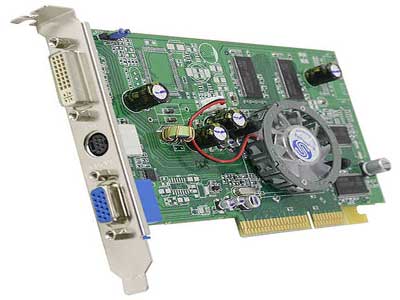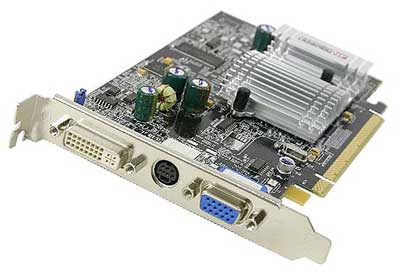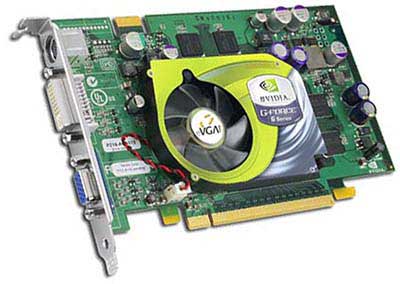Buyer's Guide - Mid-Range, October 2004
by Jarred Walton on October 21, 2004 11:00 AM EST- Posted in
- Guides
Graphics Recommendations
The only typical applications that actually require a decent graphics card are games, but depending on how you plan to use the system, adding a little more power to the graphics subsystem may not be a bad idea. We listed an integrated graphics motherboard as an option for a base Intel system, and that will save you a little money. For the AGP models, a basic Radeon or GeForce will get you by. One of the advantages of purchasing an add-in card is that even the basic models support two displays. This is definitely an advantage for software development and content creation work, where having dozens of windows open at a time is par for the course.Those who are interested in more serious work, like 3D modeling and rendering, might want to look into professional 3D graphics cards, although moderate consumer graphics cards will be sufficient for less serious work. Those looking for an all-around system will also want more than just a basic graphics card. With that said, let's get on to the recommendations.

AGP Recommendation: Sapphire Radeon 9600 Pro 128MB
Price: $108 Shipped (OEM)
At just over $100, the 9600 Pro offers tremendous value. Casual gamers will have more than enough performance for most games, while those interested in content creation or software development get the proven reliability and performance of ATI's drivers. TV Out is also included, for those who might be looking for a Home Theater PC. While it might seem like overkill for anyone who doesn't use any form of 3D graphics, it is hard to recommend anything less than a DirectX 9.0 capable graphics card for any system costing over $1000. Remember that Windows Longhorn - assuming it ships anytime soon - is going to require DX9 support as the bare minimum in order to run. The one option that isn't available for this price is dual DVI output, so those looking at running dual LCD displays might want to find a model that has two DVI ports. While the performance is lower, HIS makes a dual DVI 9600 card that might interest some of you. Downgrading to a stock 9600 or even a 9600SE is also an option if you are sure you don't need the added performance of the 9600 Pro.

Basic PCIe Recommendation: Sapphire Radeon X300 128MB
Price: $85 Shipped (OEM)
PCI Express graphics cards tend to carry a slight price premium, and the X300 is actually comparable to the 9600. The X600 Pro matches the clock speeds of the 9600 Pro, but it costs a little more. For basic computing tasks other than gaming, they will both perform acceptably, so here we go with the slightly cheaper X300. Unfortunately - or fortunately if you're looking for an excuse to upgrade - those looking for dual DVI ports will need to buy a 6600GT card for the time being; specifically, the XFX is one card that includes that option. There are no other PCI Express graphics cards with two DVI ports other than the ultra-expensive X800 XT and Quadro FX1300, which really aren't an option for this price range.

PCIe Alternative: eVGA 6600GT 128MB
Price: $207 Shipped (Retail)
Here, PCI Express has a slight advantage in the price/performance category. The 6600GT includes 8 pixel pipelines, and with a core clock of 500 MHz, it outperforms any AGP card in the same price bracket. ATI's X700 Pro is also available at about the same price and it is similar in features, but comes with 256 MB of GDDR3. The X700XT with 128 MB of RAM and faster clock speeds is also due to show up in retail any time now, but we have not been able to find it there yet. This is really a gaming option, but we would feel remiss if we didn't at least mention it, as the 6600GT is one of the best price/performance graphics cards currently available.
For AGP systems that will be used for moderate amounts of gaming, the only comparable card right now is the 9800 Pro. It's a bit slower in most games and lacks support for SM3.0 but it performs acceptably. The GeForce 6800 is also an option that is slightly faster than the 6600GT and costs a bit more.










54 Comments
View All Comments
hh - Friday, October 22, 2004 - link
#8/gimper48> Very good. I am impressed. However, are we
> going to see benchmarks in these anytime soon?
Benchmarks are merely a tool to try to determine whats better/worse/"equivalent" for its price.
And I do realize that this may be somewhat contrary to the general intent of the article, but we do have to recognize that DIY'ing falls into two basic motivational catagories: those who do it because they enjoy it (hobby) and those who want to save money vs. OEM (value).
For the latter, it comes down to cost:performance. As a example, taking the $1250 system upgraded to the 17" LCD monitor and XP/P OS puts us at roughly $1500. Now suppose that we could get an "equivalent" system (performance) but someone else did the assembly, optimization and compatibility hassles, performed the OS installation, and gave us a warranty. Clearly, that PC build wouild be worth more, but how much more?
One OEM example to consider is the Apple iMac 1.6Gz G5 17" at $1300 + 1GB aftermarket RAM upgrade +$250, which puts us at a $1550 pricepoint.
For this example, the value-added extras of hardware assembly, optimization/compatibility/debug, the OS install and a system warranty is only $50 more. YMMV if this is small enough for many value-oriented people would be willing to pay for (IMO, yes).
The remaining question is if such a $1550 OEM system is/isn't "equivalent" to the $1500 DIY system to conclude which is the better overall consumer value.
And because of the Apple here, the "equivalency" question is a huge gaping hole. That's no accident: I did it on purpose because my intent is to look at this more rhetorically to as to illustrate the philisophical, not to introduce a Mac performance debate (so please don't). Yes, I could have chosen a Dell or Gateway, but I loathe their websites and they typically have too many hardware variables that would only drag us down into the weeds instead of seeing the basics of the big picture first.
This article was interesting reading. Thanks again.
-hh
draazeejs - Friday, October 22, 2004 - link
Why did they change the HDD recommendation from Seagate to Samsung? Does anyone have experience with how loud those drives are? I have a Barracuda IV, 40GB, and that one is totally silent. As far as I have heard the new Barracudas are much louder. Why is that so?PrinceGaz - Friday, October 22, 2004 - link
If the NEC ND-3500A lives up to the standards of the previous ND-2500A/2510A, then its likely to be the best drive in its class with standard firmware. The quality and value of those drives was unbeatable.Hacked firmware to add more media types or higher burn speeds with them is a nice bonus for those who want it, but is totally optional. The drives are still excellent straight out the box.
deathwalker - Friday, October 22, 2004 - link
#28..I don't think recommendations for a Optical drive should be based on "hacked" firmware...I'm sticking with my original thought that the Pioneer drive would have seemed like the likely choice based upon there recent review..having said that though, I'nm sure the NEC drive is a fine drive also.MustISO - Friday, October 22, 2004 - link
Looking at the memory chart, RAM is really going up. That sucks!iversonyin - Friday, October 22, 2004 - link
logitech > MS when it come to mouseMIDIman - Friday, October 22, 2004 - link
> The NEC is a little curious though, given the> glowing review of the Pioneer a few weeks
> ago...
I think the point here might be post hacked firmware. After flashing my 3500a, its quite incredible what its capable of, and its possible that anandtech has already done an NEC article and just hasn't put it up quite yet.
Murmandamus - Friday, October 22, 2004 - link
Great guide!I'm considering setting up an HTPC. So I would sure like to see a htpc guide from you guys.
Thanks!
JarredWalton - Friday, October 22, 2004 - link
Let's just say I have insider information from Kristopher. Blame him. ;)gherald - Friday, October 22, 2004 - link
> #5 - Posted on Oct 21, 2004 at 1:34 PM by PrinceGaz wrote:> I've just finished reading it and amazingly, I can't fault any of your recommendations!
I have to agree! In particular it's great to finally start seeing good case/PSUs from Antec and Shuttle.
The NEC is a little curious though, given the glowing review of the Pioneer a few weeks ago...